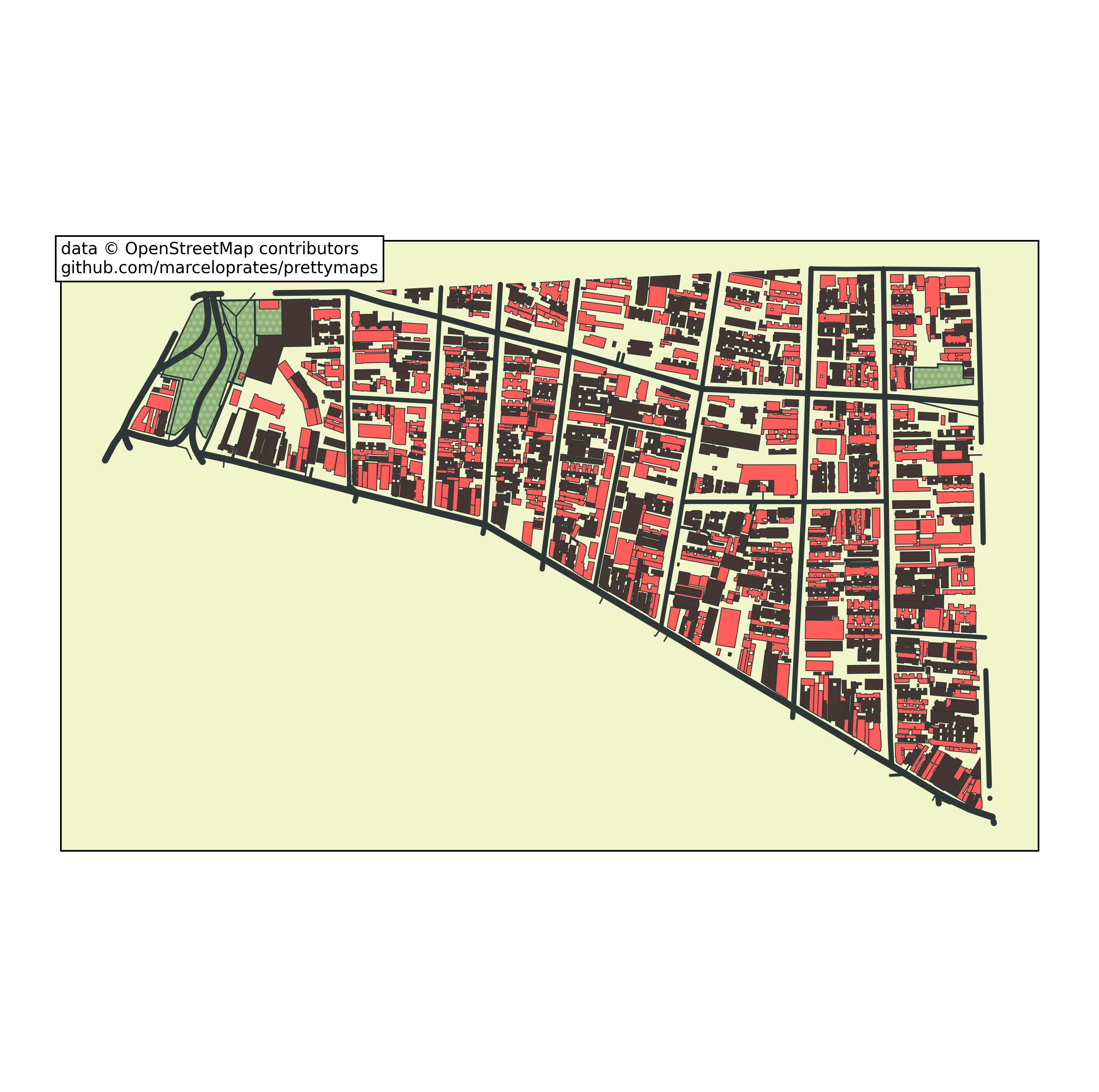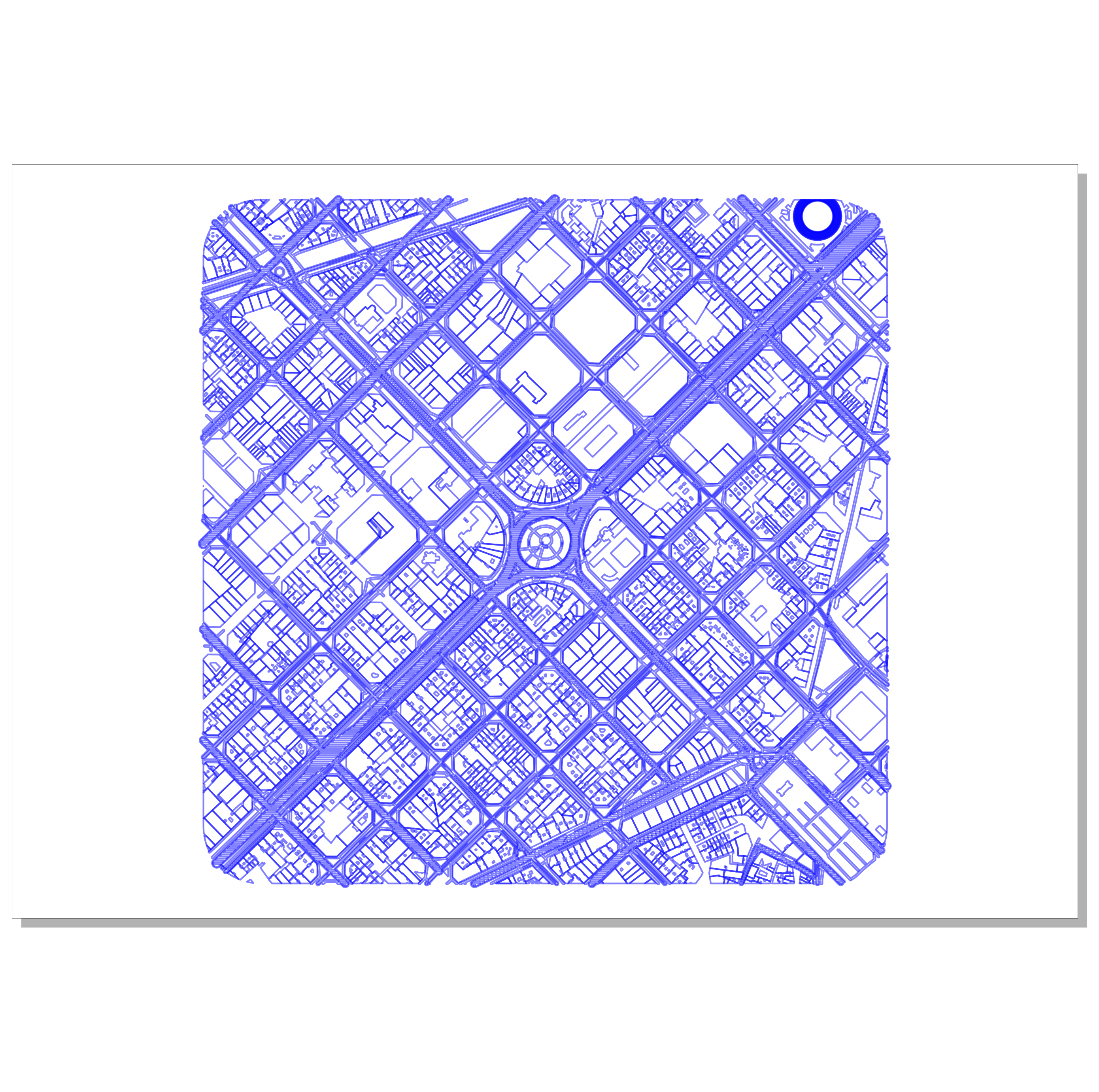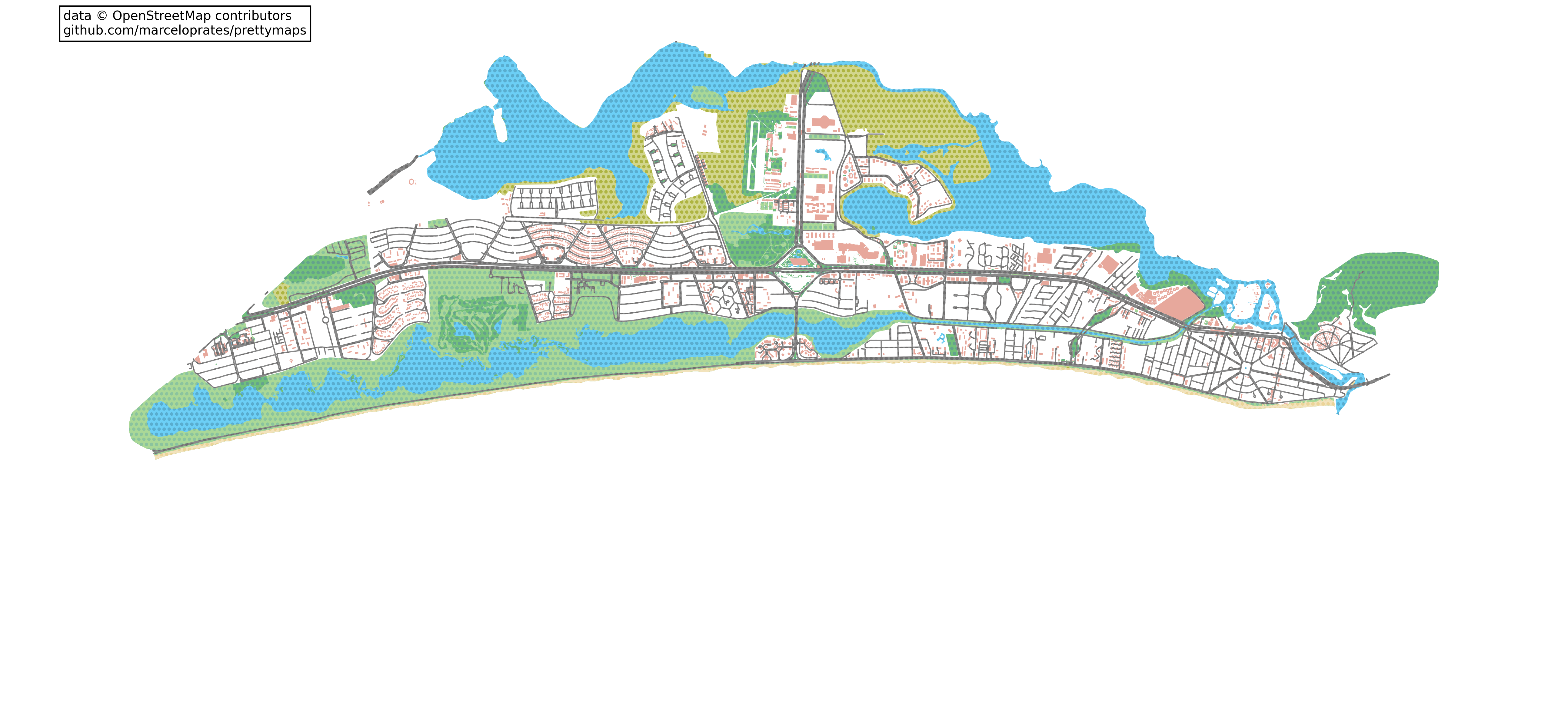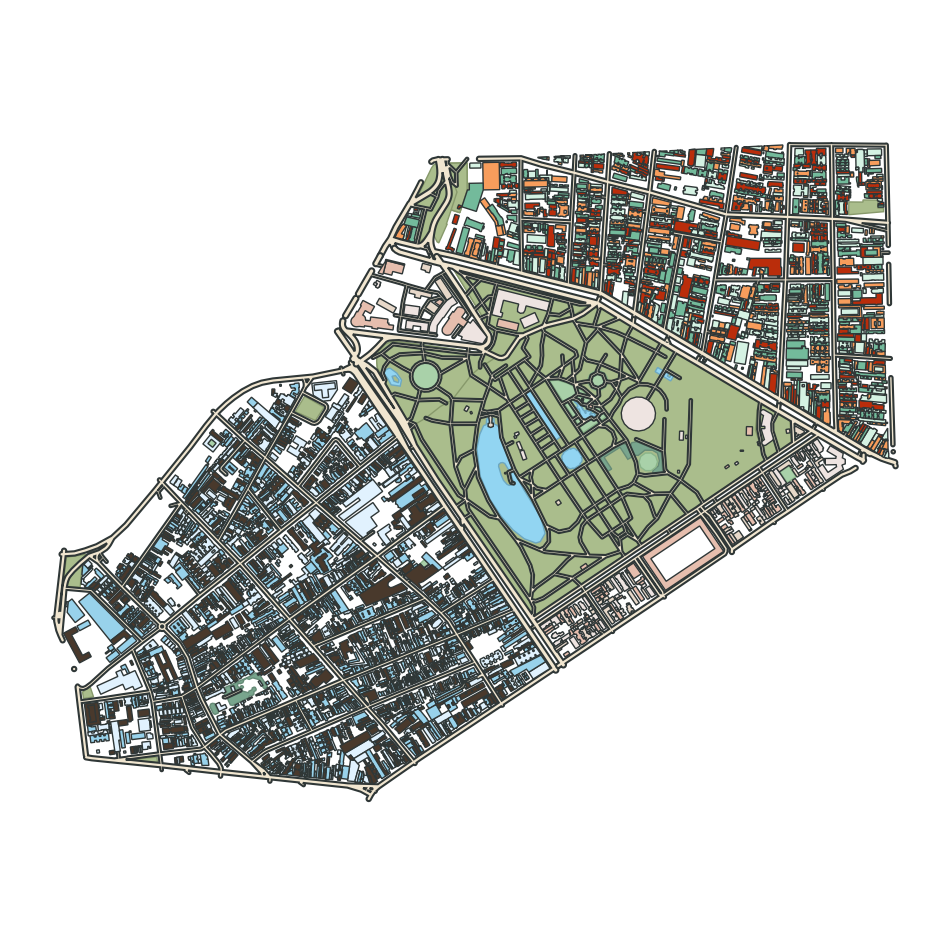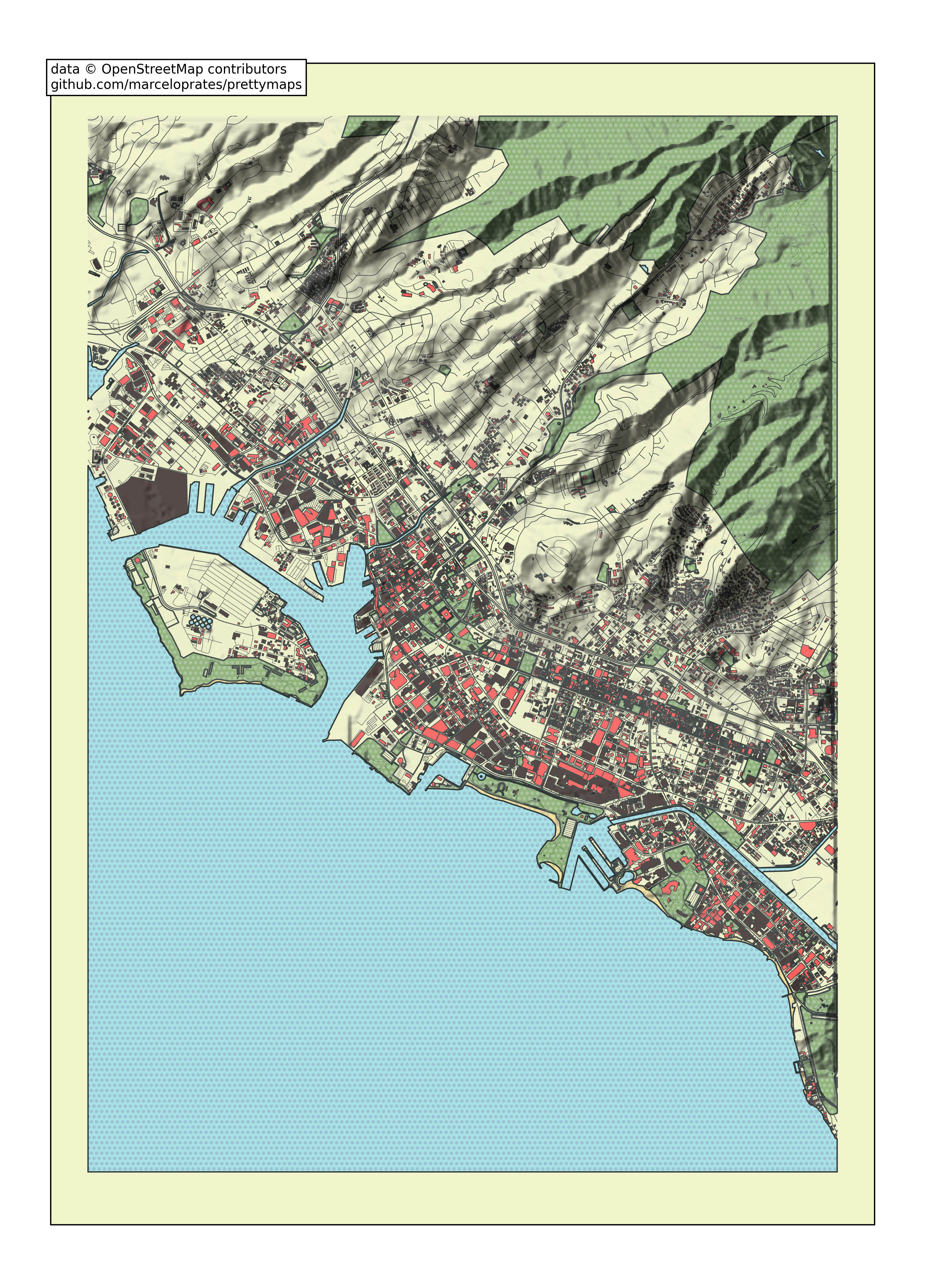prettymaps
A minimal Python library to draw customized maps from OpenStreetMap created using the osmnx, matplotlib, shapely and vsketch packages.
This work is licensed under a GNU Affero General Public License v3.0 (you can make commercial use, distribute and modify this project, but must disclose the source code with the license and copyright notice)
Note about crediting and NFTs:
- Please keep the printed message on the figures crediting my repository and OpenStreetMap (mandatory by their license).
- I am personally against NFTs for their environmental impact, the fact that they're a giant money-laundering pyramid scheme and the structural incentives they create for theft in the open source and generative art communities.
- I do not authorize in any way this project to be used for selling NFTs, although I cannot legally enforce it. Respect the creator.
- The AeternaCivitas and geoartnft projects have used this work to sell NFTs and refused to credit it. See how they reacted after being exposed: AeternaCivitas, geoartnft.
- I have closed my other generative art projects on Github and won't be sharing new ones as open source to protect me from the NFT community.
As seen on Hacker News:
prettymaps subreddit
Google Colaboratory Demo
Installation
Install locally:
Install prettymaps with:
pip install prettymaps
Install on Google Colaboratory:
Install prettymaps with:
!pip install -e "git+https://github.com/marceloprates/prettymaps#egg=prettymaps"
Then restart the runtime (Runtime -> Restart Runtime) before importing prettymaps
Run front-end
After prettymaps is installed, you can run the front-end (streamlit) application from the prettymaps repository using:
streamlit run app.py
Tutorial
Plotting with prettymaps is very simple. Run:
prettymaps.plot(your_query)
your_query can be:
- An address (Example: "Porto Alegre"),
- Latitude / Longitude coordinates (Example: (-30.0324999, -51.2303767))
- A custom boundary in GeoDataFrame format
%reload_ext autoreload
%autoreload 2
import prettymaps
plot = prettymaps.plot('Stad van de Zon, Heerhugowaard, Netherlands')
Fetching geodataframes took 13.14 seconds
You can also choose from different "presets" (parameter combinations saved in JSON files)
See below an example using the "minimal" preset
import prettymaps
plot = prettymaps.plot(
'Stad van de Zon, Heerhugowaard, Netherlands',
preset = 'minimal'
)
Fetching geodataframes took 4.78 seconds
Run
prettymaps.presets()
to list all available presets:
import prettymaps
prettymaps.presets()
.dataframe tbody tr th {
vertical-align: top;
}
.dataframe thead th {
text-align: right;
}
</style>
| preset | params | |
|---|---|---|
| 0 | abraca-redencao | {'layers': {'perimeter': {}, 'streets': {'widt... |
| 1 | barcelona | {'layers': {'perimeter': {'circle': False}, 's... |
| 2 | barcelona-plotter | {'layers': {'streets': {'width': {'primary': 5... |
| 3 | cb-bf-f | {'layers': {'streets': {'width': {'trunk': 6, ... |
| 4 | default | {'layers': {'perimeter': {}, 'streets': {'widt... |
| 5 | heerhugowaard | {'layers': {'perimeter': {}, 'streets': {'widt... |
| 6 | macao | {'layers': {'perimeter': {}, 'streets': {'cust... |
| 7 | minimal | {'layers': {'perimeter': {}, 'streets': {'widt... |
| 8 | plotter | {'layers': {'perimeter': {}, 'streets': {'widt... |
| 9 | tijuca | {'layers': {'perimeter': {}, 'streets': {'widt... |
To examine a specific preset, run:
import prettymaps
prettymaps.preset('default')
Preset(params={'layers': {'perimeter': {}, 'streets': {'width': {'motorway': 5, 'trunk': 5, 'primary': 4.5, 'secondary': 4, 'tertiary': 3.5, 'cycleway': 3.5, 'residential': 3, 'service': 2, 'unclassified': 2, 'pedestrian': 2, 'footway': 1}}, 'waterway': {'tags': {'waterway': ['river', 'stream']}, 'width': {'river': 20, 'stream': 10}}, 'building': {'tags': {'building': True, 'landuse': 'construction'}}, 'water': {'tags': {'natural': ['water', 'bay']}}, 'sea': {}, 'forest': {'tags': {'landuse': 'forest'}}, 'green': {'tags': {'landuse': ['grass', 'orchard'], 'natural': ['island', 'wood', 'wetland'], 'leisure': 'park'}}, 'rock': {'tags': {'natural': 'bare_rock'}}, 'beach': {'tags': {'natural': 'beach'}}, 'parking': {'tags': {'amenity': 'parking', 'highway': 'pedestrian', 'man_made': 'pier'}}}, 'style': {'perimeter': {'fill': False, 'lw': 0, 'zorder': 0}, 'background': {'fc': '#F2F4CB', 'zorder': -1}, 'green': {'fc': '#8BB174', 'ec': '#2F3737', 'hatch_c': '#A7C497', 'hatch': 'ooo...', 'lw': 1, 'zorder': 1}, 'forest': {'fc': '#64B96A', 'ec': '#2F3737', 'lw': 1, 'zorder': 2}, 'water': {'fc': '#a8e1e6', 'ec': '#2F3737', 'hatch_c': '#9bc3d4', 'hatch': 'ooo...', 'lw': 1, 'zorder': 99}, 'sea': {'fc': '#a8e1e6', 'ec': '#2F3737', 'hatch_c': '#9bc3d4', 'hatch': 'ooo...', 'lw': 1, 'zorder': 99}, 'waterway': {'fc': '#a8e1e6', 'ec': '#2F3737', 'hatch_c': '#9bc3d4', 'hatch': 'ooo...', 'lw': 1, 'zorder': 200}, 'beach': {'fc': '#FCE19C', 'ec': '#2F3737', 'hatch_c': '#d4d196', 'hatch': 'ooo...', 'lw': 1, 'zorder': 3}, 'parking': {'fc': '#F2F4CB', 'ec': '#2F3737', 'lw': 1, 'zorder': 3}, 'streets': {'fc': '#2F3737', 'ec': '#475657', 'alpha': 1, 'lw': 0, 'zorder': 4}, 'building': {'palette': ['#433633', '#FF5E5B'], 'ec': '#2F3737', 'lw': 0.5, 'zorder': 5}, 'rock': {'fc': '#BDC0BA', 'ec': '#2F3737', 'lw': 1, 'zorder': 6}}, 'circle': None, 'radius': 500})
Insted of using the default configuration you can customize several parameters. The most important are:
- layers: A dictionary of OpenStreetMap layers to fetch.
- Keys: layer names (arbitrary)
- Values: dicts representing OpenStreetMap queries
- style: Matplotlib style parameters
- Keys: layer names (the same as before)
- Values: dicts representing Matplotlib style parameters
plot = prettymaps.plot(
# Your query. Example: "Porto Alegre" or (-30.0324999, -51.2303767) (GPS coords)
your_query,
# Dict of OpenStreetMap Layers to plot. Example:
# {'building': {'tags': {'building': True}}, 'water': {'tags': {'natural': 'water'}}}
# Check the /presets folder for more examples
layers,
# Dict of style parameters for matplotlib. Example:
# {'building': {'palette': ['#f00','#0f0','#00f'], 'edge_color': '#333'}}
style,
# Preset to load. Options include:
# ['default', 'minimal', 'macao', 'tijuca']
preset,
# Save current parameters to a preset file.
# Example: "my-preset" will save to "presets/my-preset.json"
save_preset,
# Whether to update loaded preset with additional provided parameters. Boolean
update_preset,
# Plot with circular boundary. Boolean
circle,
# Plot area radius. Float
radius,
# Dilate the boundary by this amount. Float
dilate
)
plot is a python dataclass containing:
@dataclass
class Plot:
# A dictionary of GeoDataFrames (one for each plot layer)
geodataframes: Dict[str, gp.GeoDataFrame]
# A matplotlib figure
fig: matplotlib.figure.Figure
# A matplotlib axis object
ax: matplotlib.axes.Axes
Here's an example of running prettymaps.plot() with customized parameters:
import prettymaps
plot = prettymaps.plot(
'Praça Ferreira do Amaral, Macau',
circle = True,
radius = 1100,
layers = {
"green": {
"tags": {
"landuse": "grass",
"natural": ["island", "wood"],
"leisure": "park"
}
},
"forest": {
"tags": {
"landuse": "forest"
}
},
"water": {
"tags": {
"natural": ["water", "bay"]
}
},
"parking": {
"tags": {
"amenity": "parking",
"highway": "pedestrian",
"man_made": "pier"
}
},
"streets": {
"width": {
"motorway": 5,
"trunk": 5,
"primary": 4.5,
"secondary": 4,
"tertiary": 3.5,
"residential": 3,
}
},
"building": {
"tags": {"building": True},
},
},
style = {
"background": {
"fc": "#F2F4CB",
"ec": "#dadbc1",
"hatch": "ooo...",
},
"perimeter": {
"fc": "#F2F4CB",
"ec": "#dadbc1",
"lw": 0,
"hatch": "ooo...",
},
"green": {
"fc": "#D0F1BF",
"ec": "#2F3737",
"lw": 1,
},
"forest": {
"fc": "#64B96A",
"ec": "#2F3737",
"lw": 1,
},
"water": {
"fc": "#a1e3ff",
"ec": "#2F3737",
"hatch": "ooo...",
"hatch_c": "#85c9e6",
"lw": 1,
},
"parking": {
"fc": "#F2F4CB",
"ec": "#2F3737",
"lw": 1,
},
"streets": {
"fc": "#2F3737",
"ec": "#475657",
"alpha": 1,
"lw": 0,
},
"building": {
"palette": [
"#FFC857",
"#E9724C",
"#C5283D"
],
"ec": "#2F3737",
"lw": 0.5,
}
}
)
Fetching geodataframes took 27.07 seconds
In order to plot an entire region and not just a rectangular or circular area, set
radius = False
import prettymaps
plot = prettymaps.plot(
'Bom Fim, Porto Alegre, Brasil', radius = False,
)
Fetching geodataframes took 11.25 seconds
You can access layers's GeoDataFrames directly like this:
import prettymaps
# Run prettymaps in show = False mode (we're only interested in obtaining the GeoDataFrames)
plot = prettymaps.plot('Centro Histórico, Porto Alegre', show = False)
plot.geodataframes['building']
Fetching geodataframes took 12.99 seconds
.dataframe tbody tr th {
vertical-align: top;
}
.dataframe thead th {
text-align: right;
}
</style>
| geometry | bicycle | highway | leisure | addr:housenumber | addr:street | amenity | operator | website | historic | ... | contact:website | bus | smoothness | inscription | ways | boat | name:fr | type | building:part | architect | |
|---|---|---|---|---|---|---|---|---|---|---|---|---|---|---|---|---|---|---|---|---|---|
| (node, 2407915698) | POINT (-51.23212 -30.03670) | NaN | NaN | NaN | 820 | Rua Washington Luiz | NaN | NaN | NaN | NaN | ... | NaN | NaN | NaN | NaN | NaN | NaN | NaN | NaN | NaN | NaN |
| (way, 126665330) | POLYGON ((-51.23518 -30.03275, -51.23512 -30.0... | NaN | NaN | NaN | 387 | Rua dos Andradas | place_of_worship | NaN | NaN | NaN | ... | NaN | NaN | NaN | NaN | NaN | NaN | NaN | NaN | NaN | NaN |
| (way, 126665331) | POLYGON ((-51.23167 -30.03066, -51.23160 -30.0... | NaN | NaN | NaN | 1001 | Rua dos Andradas | NaN | NaN | https://www.ruadapraiashopping.com.br/ | NaN | ... | NaN | NaN | NaN | NaN | NaN | NaN | NaN | NaN | NaN | NaN |
| (way, 129176990) | POLYGON ((-51.23117 -30.02891, -51.23120 -30.0... | NaN | NaN | NaN | 1020 | Rua 7 de Setembro | NaN | NaN | http://www.memorial.rs.gov.br | NaN | ... | NaN | NaN | NaN | NaN | NaN | NaN | NaN | NaN | NaN | NaN |
| (way, 129176991) | POLYGON ((-51.23153 -30.02914, -51.23156 -30.0... | NaN | NaN | NaN | NaN | Praça da Alfândega | NaN | NaN | https://www.margs.rs.gov.br/ | NaN | ... | NaN | NaN | NaN | NaN | NaN | NaN | NaN | NaN | NaN | NaN |
| ... | ... | ... | ... | ... | ... | ... | ... | ... | ... | ... | ... | ... | ... | ... | ... | ... | ... | ... | ... | ... | ... |
| (relation, 6760281) | POLYGON ((-51.23238 -30.03337, -51.23223 -30.0... | NaN | NaN | NaN | NaN | NaN | NaN | NaN | NaN | NaN | ... | NaN | NaN | NaN | NaN | [457506887, 457506886] | NaN | NaN | multipolygon | NaN | NaN |
| (relation, 6760282) | POLYGON ((-51.23203 -30.03340, -51.23203 -30.0... | NaN | NaN | NaN | NaN | NaN | NaN | NaN | NaN | NaN | ... | NaN | NaN | NaN | NaN | [457506875, 457506889, 457506888] | NaN | NaN | multipolygon | NaN | NaN |
| (relation, 6760283) | POLYGON ((-51.23284 -30.03367, -51.23288 -30.0... | NaN | NaN | NaN | NaN | NaN | NaN | NaN | NaN | NaN | ... | NaN | NaN | NaN | NaN | [457506897, 457506896] | NaN | NaN | multipolygon | NaN | Theodor Wiederspahn |
| (relation, 6760284) | POLYGON ((-51.23499 -30.03412, -51.23498 -30.0... | NaN | NaN | NaN | NaN | NaN | NaN | NaN | NaN | NaN | ... | NaN | NaN | NaN | NaN | [457506910, 457506913] | NaN | NaN | multipolygon | NaN | NaN |
| (relation, 14393526) | POLYGON ((-51.23125 -30.02813, -51.23128 -30.0... | NaN | NaN | NaN | 1044 | Rua Siqueira Campos | NaN | NaN | https://www.sefaz.rs.gov.br | NaN | ... | NaN | NaN | NaN | NaN | [236213286, 1081974882] | NaN | NaN | multipolygon | NaN | NaN |
2420 rows × 167 columns
Search a building by name and display it:
plot.geodataframes['building'][
plot.geodataframes['building'].name == 'Catedral Metropolitana Nossa Senhora Mãe de Deus'
].geometry[0]
/opt/hostedtoolcache/Python/3.11.13/x64/lib/python3.11/site-packages/geopandas/geoseries.py:648: FutureWarning: Series.__getitem__ treating keys as positions is deprecated. In a future version, integer keys will always be treated as labels (consistent with DataFrame behavior). To access a value by position, use `ser.iloc[pos]`
val = getattr(super(), mtd)(*args, **kwargs)
Plot mosaic of building footprints
import prettymaps
import numpy as np
import osmnx as ox
from matplotlib import pyplot as plt
# Run prettymaps in show = False mode (we're only interested in obtaining the GeoDataFrames)
plot = prettymaps.plot('Porto Alegre', show = False)
# Get list of buildings from plot's geodataframes dict
buildings = plot.geodataframes['building']
# Project from lat / long
buildings = ox.project_gdf(buildings)
buildings = [b for b in buildings.geometry if b.area > 0]
# Draw Matplotlib mosaic of n x n building footprints
n = 6
fig,axes = plt.subplots(n,n, figsize = (7,6))
# Set background color
fig.patch.set_facecolor('#5cc0eb')
# Figure title
fig.suptitle(
'Buildings of Porto Alegre',
size = 25,
color = '#fff'
)
# Draw each building footprint on a separate axis
for ax,building in zip(np.concatenate(axes),buildings):
ax.plot(*building.exterior.xy, c = '#ffffff')
ax.autoscale(); ax.axis('off'); ax.axis('equal')
Fetching geodataframes took 12.91 seconds
Access plot.ax or plot.fig to add new elements to the matplotlib plot:
import prettymaps
plot = prettymaps.plot(
(41.39491,2.17557),
preset = 'barcelona',
show = False # We don't want to render the map yet
)
# Change background color
plot.fig.patch.set_facecolor('#F2F4CB')
# Add title
_ = plot.ax.set_title(
'Barcelona',
font = 'serif',
size = 50
)
Fetching geodataframes took 12.92 seconds
Use plotter mode to export a pen plotter-compatible SVG (thanks to abey79's amazing vsketch library)
import prettymaps
plot = prettymaps.plot(
(41.39491,2.17557),
mode = 'plotter',
layers = dict(perimeter = {}),
preset = 'barcelona-plotter',
scale_x = .6,
scale_y = -.6,
)
Fetching geodataframes took 3.91 seconds
Some other examples
import prettymaps
plot = prettymaps.plot(
'Barra da Tijuca',
dilate = 0,
figsize = (22,10),
preset = 'tijuca',
adjust_aspect_ratio = False
)
Fetching geodataframes took 27.11 seconds
Use prettymaps.create_preset() to create a preset:
import prettymaps
prettymaps.create_preset(
"my-preset",
layers = {
"building": {
"tags": {
"building": True,
"leisure": [
"track",
"pitch"
]
}
},
"streets": {
"width": {
"trunk": 6,
"primary": 6,
"secondary": 5,
"tertiary": 4,
"residential": 3.5,
"pedestrian": 3,
"footway": 3,
"path": 3
}
},
},
style = {
"perimeter": {
"fill": False,
"lw": 0,
"zorder": 0
},
"streets": {
"fc": "#F1E6D0",
"ec": "#2F3737",
"lw": 1.5,
"zorder": 3
},
"building": {
"palette": [
"#fff"
],
"ec": "#2F3737",
"lw": 1,
"zorder": 4
}
}
)
prettymaps.preset('my-preset')
Preset(params={'layers': {'building': {'tags': {'building': True, 'leisure': ['track', 'pitch']}}, 'streets': {'width': {'trunk': 6, 'primary': 6, 'secondary': 5, 'tertiary': 4, 'residential': 3.5, 'pedestrian': 3, 'footway': 3, 'path': 3}}}, 'style': {'perimeter': {'fill': False, 'lw': 0, 'zorder': 0}, 'streets': {'fc': '#F1E6D0', 'ec': '#2F3737', 'lw': 1.5, 'zorder': 3}, 'building': {'palette': ['#fff'], 'ec': '#2F3737', 'lw': 1, 'zorder': 4}}, 'circle': None, 'radius': None, 'dilate': None})
Use prettymaps.multiplot and prettymaps.Subplot to draw multiple regions on the same canvas
import prettymaps
# Draw several regions on the same canvas
plot = prettymaps.multiplot(
prettymaps.Subplot(
'Cidade Baixa, Porto Alegre',
style={'building': {'palette': ['#49392C', '#E1F2FE', '#98D2EB']}}
),
prettymaps.Subplot(
'Bom Fim, Porto Alegre',
style={'building': {'palette': ['#BA2D0B', '#D5F2E3', '#73BA9B', '#F79D5C']}}
),
prettymaps.Subplot(
'Farroupilha, Porto Alegre',
layers = {'building': {'tags': {'building': True}}},
style={'building': {'palette': ['#EEE4E1', '#E7D8C9', '#E6BEAE']}}
),
# Load a global preset
preset='cb-bf-f',
# Figure size
figsize=(12, 12)
)
Fetching geodataframes took 8.20 seconds
Fetching geodataframes took 6.59 seconds
Fetching geodataframes took 8.09 seconds
Add hillshade
plot = prettymaps.plot(
'Honolulu',
radius = 5500,
figsize = 'a4',
layers = {'hillshade': {
'azdeg': 315,
'altdeg': 45,
'vert_exag': 1,
'dx': 1,
'dy': 1,
'alpha': 0.75,
}},
)
Fetching geodataframes took 47.61 seconds
make: Entering directory '/home/runner/work/prettymaps/prettymaps/notebooks/SRTM1'
curl -s -o spool/N21/N21W158.hgt.gz.temp https://s3.amazonaws.com/elevation-tiles-prod/skadi/N21/N21W158.hgt.gz && mv spool/N21/N21W158.hgt.gz.temp spool/N21/N21W158.hgt.gz
gunzip spool/N21/N21W158.hgt.gz 2>/dev/null || touch spool/N21/N21W158.hgt
gdal_translate -q -co TILED=YES -co COMPRESS=DEFLATE -co ZLEVEL=9 -co PREDICTOR=2 spool/N21/N21W158.hgt cache/N21/N21W158.tif 2>/dev/null || touch cache/N21/N21W158.tif
rm spool/N21/N21W158.hgt
make: Leaving directory '/home/runner/work/prettymaps/prettymaps/notebooks/SRTM1'
make: Entering directory '/home/runner/work/prettymaps/prettymaps/notebooks/SRTM1'
gdalbuildvrt -q -overwrite SRTM1.vrt cache/N21/N21W158.tif
make: Leaving directory '/home/runner/work/prettymaps/prettymaps/notebooks/SRTM1'
make: Entering directory '/home/runner/work/prettymaps/prettymaps/notebooks/SRTM1'
cp SRTM1.vrt SRTM1.65e8f0bb4b43451a865dc35dca4158a5.vrt
make: Leaving directory '/home/runner/work/prettymaps/prettymaps/notebooks/SRTM1'
make: Entering directory '/home/runner/work/prettymaps/prettymaps/notebooks/SRTM1'
gdal_translate -q -co TILED=YES -co COMPRESS=DEFLATE -co ZLEVEL=9 -co PREDICTOR=2 -projwin -157.90125854957773 21.364471426268267 -157.81006761682832 21.244615177105388 SRTM1.65e8f0bb4b43451a865dc35dca4158a5.vrt /home/runner/work/prettymaps/prettymaps/notebooks/elevation.tif
rm -f SRTM1.65e8f0bb4b43451a865dc35dca4158a5.vrt
make: Leaving directory '/home/runner/work/prettymaps/prettymaps/notebooks/SRTM1'
WARNING:matplotlib.axes._base:Ignoring fixed y limits to fulfill fixed data aspect with adjustable data limits.
Add keypoints
plot = prettymaps.plot(
'Garopaba',
radius = 5000,
figsize = 'a4',
layers = {'building': False},
keypoints = {
# Search for general keypoints specified by OSM tags
'tags': {'natural': ['beach']},
# Or, search by specific name or free-text search
# pretymaps will use a fuzzy string matching to search for the specified name
'specific': {
'pedra branca': {'tags': {'natural': ['peak']}},
}
},
)
Fetching geodataframes took 17.57 seconds









